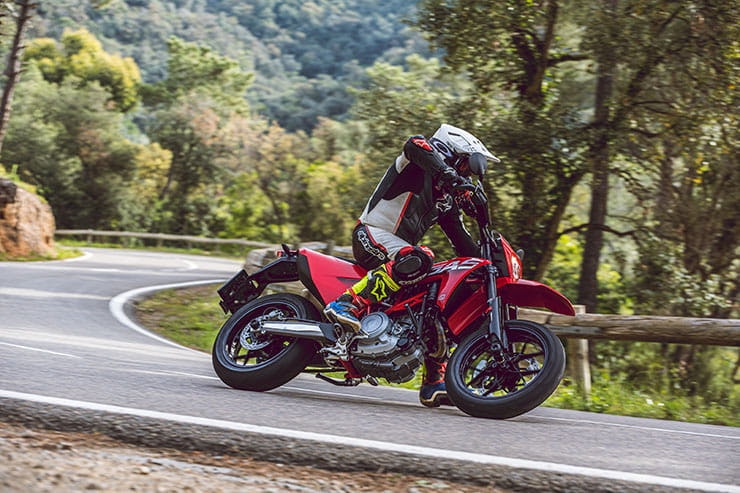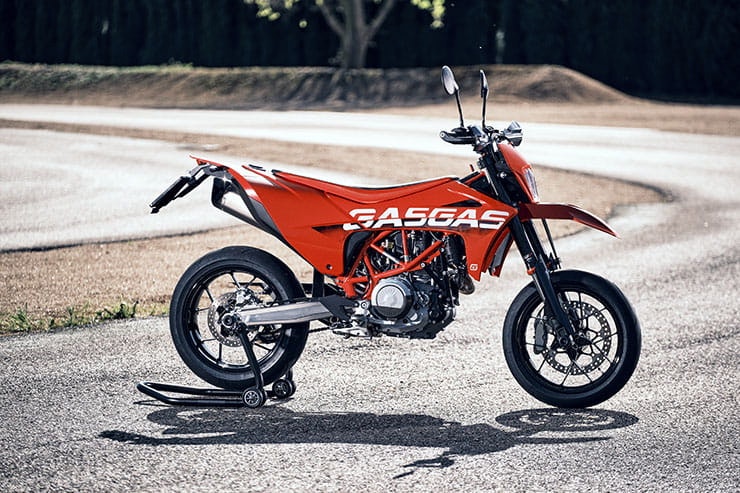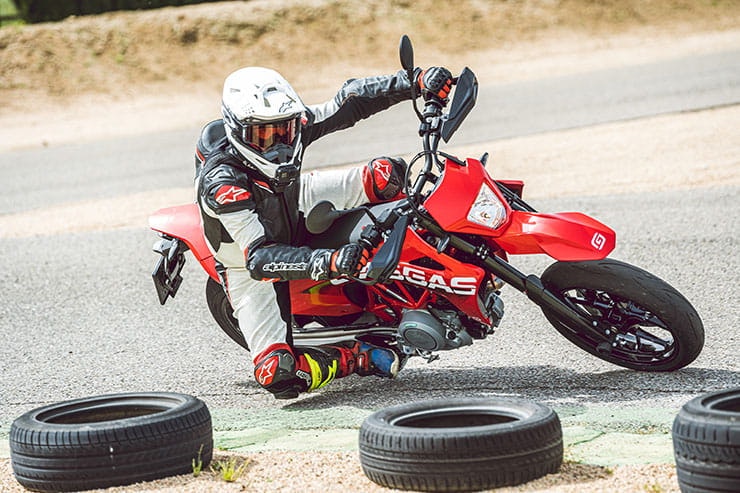GasGas SM 700 (2022) - Review
BikeSocial Road Tester
16.05.2022
Launch price: £9,349 | Power: 74bhp | Torque: 54.2 lb.ft | Weight: 148.5kg (dry) | Rating: 4/5
Suddenly GasGas is out there. The Spanish manufacturer may be famous in trials circles for its log-hopping masterpieces but for road riders the marque is largely anonymous. At least it was. In 2020 GasGas set out to relaunch its brand, moving away from its traditional niche off-road market and into MotoGP to contest in the Moto3 championship. Following dramatic success at the famous Dakar Rally in January, the factory raised its profile further by badging Jake Dixon’s Moto2 Triumph-powered Kalex as a GasGas. And now we have its first production road bike; the SM 700.
The movers and shakers behind the transformation of GasGas is parent company PIERER Mobility, which also owns KTM and Husqvarna, meaning it should come as no surprise that the ‘new’ SM 700 supermoto shares just about everything with the KTM690 SMC R and Husqvarna 701. In fact, the 693cc 74hp single-cylinder engine is identical, as is the fully adjustable WP suspension and trellis frame. Even the £9349 price is the same across the board.
We flew to Barcelona, Spain, to try out GasGas’s first road bike, on both the road and track.
Fabulously entertaining
Good looks
Lightweight handling on road and track
Pricey for a toy
Not great over long distances
Basic controls and screen
REVIEW: GasGas SM 700 (2022)
Adam ‘Chad’ Child goes to Spain to ride the new single-cylinder, road-legal Supermoto from GasGas
GasGas SM 700 (2022) Price
How much is the GasGas SM 700? £9349
Clearly, GasGas, KTM, and Husqvarna all had lunch together when price points were being discussed: at £9349 the SM700 is the same price as the family competition.
Two decades ago, the supermoto market was flooded with exciting options, but now they are a little thin on the ground. Ducati has the Hypermotard, but the 114hp V-twin (£12,695) isn’t really in the same game as the lightweight GasGas 700 – the Italian is more road-focused and versatile.
Is £9349 too much for a single-cylinder supermoto? Arguably so, when you consider that other apex-hunters like KTM’s own 890 Duke are just £10,049 and capable of much more. But the GasGas is certainly packed with quality components as well as sophisticated lean- sensitive rider aids.
Power and torque
Yes, you guessed correctly: the SM 700’s engine performance is identical to both the Husqvarna’s and the KTM’s. This means the GasGas boasts a peak power figure of 74hp/55kw at 8000rpm, and a peak torque output of 73.5Nm/52.4lbft at 6500rpm. The LC4 motor was updated in 2019 and given a 7bhp boost in the process, which makes it the most powerful single-cylinder engine available today.
Singles aren’t for everyone, but they are slim, relatively simple and, crucially on a scratcher like this, light. The LC4 weighs just 43.5kg, including the electric start, throttle body, clutch, and coolant lines. It’s ride-by-wire, of course, and supported by two riding modes: Street and Supermoto, which even I understand. Each mode reconfigures the throttle response and rider aids. An up-and-down quick-shifter comes as standard along with the must-have on all supermoto machines – a slipper clutch, which on the GasGas is hydraulically operated.
Engine, gearbox, and exhaust
Don’t be put-off by the fact the SM used a single-cylinder engine. The LC4 is as far removed from the shaky old one-lungers of the old days as a Eurofighter from a Tiger Moth, and there’s certainly no kickstarter to thwack into your shin bone when you try to start it either.
KTM has persisted with the single-cylinder layout and developed the sohc LC4 into a sophisticated and versatile motor – and largely eliminated the dreaded vibration associated with old plonkers in the process. Once above 2500rpm it feels exceptionally smooth and free-revving for a single, and despite the large circumference of the piston, is happy to dance up and down without resistance to 8000rpm, where the SM 700 reaches peak power.
Below 2500rpm, especially in the higher gears, it’s a little lumpy but tap back on the quick-shifter and it will pull cleanly. Short shifting through the torque of the midrange is a truly fruity experience and allows you to make quick progress on the road and embarrass most traffic away from the lights, too. Fuelling is precise and smooth, another massive step forward from the single-cylinder bikes your dad used to tear about on, while vibrations are noticeable but anything but intrusive at motorway cruising speeds.
But the real difference is this; you can also thrash the GasGas and have some serious fun. It’s been a while since I’ve ridden a modern single, and it took me a few miles to stop short-shifting and let it rev its head off instead. On the track you can hold onto a gear for longer than you’d expect, occasionally bouncing it off the rev limiter between corners, and the GasGas seems to love it. Tuck down behind the wide Supermoto bars and it will breeze past an indicated 100mph and onwards to 110mph plus a little more.
Handling, suspension, and weight
Here are some numbers to whet your appetite: 148.5kg dry, 74bhp, 73.5Nm. Add fully adjustable WP suspension and Continental Attack SM rubber on 17-inch wheels – not a bad recipe for some top-class entertainment. But first, some riding tips…
There are three ways to ride the GasGas. Conventionally: sitting still on the racy seat and using the single’s pleasing dollops of torque, which feels a bit lazy on a bike this intense but is a great way to revel in its chassis’s responsiveness. Secondly, traditional Supermoto: weight forward, inside leg out, braking late, sliding the rear to the apex as you push the bike down into the corner before turning and firing out. Or, as my instructor, MotoGP legend Sete Gibernau advised, knee down: as if on a normal sportsbike at a trackday, with your weight off the inside of the bike, knee skimming the kerb before pushing the bike upright on the exit.
And the GasGas loves all three. Ride ‘conventionally’ on the road, then get to the track or even fast switchback mountain pass and hit it supermoto style or even knee down. And, if you like intense bikes like this, all three are totally absorbing. The GasGas steers so quickly, is so incredibly light compared to normal bikes, that it takes a period of adjustment to get fully onto its wavelength. Those wide bars work like long levers and make the steering super light as, in all probability, do the SM’s cast wheels, which are lighter than the spoked rims on the KTM and Husqvarna. That said, they are only a fraction lighter (0.5kg) and mainly there for looks, and it’s not like the KTM and Husqvarna steer like a pair of raked out choppers with their spoked wheels.
The SM 700 is beautifully set up, too. On the racetrack we didn’t need to adjust the fully adjustable WP suspension and didn’t even drop the tyre pressures; just rolled onto the private racetrack (at Sete’s house, by the way) and had fun. A tight and twisty track like this is where the GasGas truly shines, and unlike a 200bhp superbike is brilliant at relatively low speeds. You’re not wrestling 220kg, just riding a bike that wants to get you into and out of the next corner as quickly as possible. And after a 20-minute track session it, instead of feeling drained you’re keen ready for another fun session.
This was my first time on the Continental Attack SM tyres and they were faultless on the road and track. Even when the pegs started to tickle the surface, I still felt confident in the grip and feel. And while the SM 700 generates superb mechanical grip there are also excellent rider aids to fall back on too. Traction control and ABS are both lean-sensitive in the street mode. In Supermoto mode the TC will allow a small slide, and the ABS is active on the front wheel only. Use the bike’s torque, get on the power incredibly early, the chassis (and TC) finds gip and propels you forward, darting away from the apex like a greyhound after a rabbit.
The only real downside is that, on track, it does take a little getting used to. You have to commit. If you sit conventionally in the seat and roll into corners, you’re asking a lot of the front WP forks and grip of the Conti rubber. Better to ride hard: brake heavily, get the forks compressed, turn while still on the brakes, and get the rear nice and loose. The GasGas will accommodate a leisurely ride, no problem, but if you head to a trackday you need to get the supermoto-spec suspension working.
GasGas SM 700 (2022) Comfort and economy
If you want comfort, go buy a Honda Goldwing. And pillions will only upset the supermoto handling and can instead get the bus.
But there is a practical side to the GasGas. Service intervals are every 10,000km or 6,200 miles. Fuel consumption should be good with GasGas quoting 4.1 litres/100km or 57.3mpg, which from the 13.5l fuel tank (filled from the rear) will give a theoretical range of 170 miles. That’s around 140 to 150 miles before you’ll need to search for fuel. And, frankly, after 120 miles or close to two hours in the thin saddle you will want a break.
Brakes
As braking projects go, it was never going to be a hard job stopping a lightweight 148.5kg supermoto, yet GasGas haven’t tightened the budget at all. A huge single 320mm disc, with a Brembo four-piston monobloc calliper do the job supported by the Bosch cornering ABS system (as we’re not all supermoto experts).
The added safety of the corning ABS gives you the confidence to brake hard and deep to the apex, getting those forks compressed. The Brembos are strong, braking distances are short. Supermoto mode disengages the rear allowing you to drift into corners, or just pull big skids whilst pretending to look good.
Away from the track, the stoppers have a lovely feel and an adjustable lever. Again, the lean-sensitive ABS will come in useful in mixed conditions, and when carving up city traffic, which the GasGas will do all too easily.
Above: Sete Gibernau shows us how it’s done in his own back yard
Rider aids, extra equipment, and accessories
There are two riding modes: Street and Supermoto. Each mode gives full power but with its own throttle map. Cornering ABS and TC for the road in Street, and ABS just on the front, and less sensitive TC on the rear in Supermoto.
The front wheel will lift a fraction in Street mode, a foot or so off the ground depending on speed and gear. But for effortless wheelies, you’ll need to opt for the Supermoto mode. Should you wish to, TC can be turned off, but it can’t be trimmed – it’s either Street or Supermoto or off. Cornering ABS can’t be switched off either. An up-and-down quick-shifter comes as standard, disabling the clutch, and works the same in each mode.
GasGas offer all the aftermarket goodies you’ll need for the track: handguards, crash protection, service pit mat, tools and, obviously, a choice of three slip-on street exhausts. Away from the track, there are rear racks, smartphone brackets and an ergo seat.
GasGas SM 700 (2022) Rivals
Here’s a high-level comparison of its nearest competitors:
Engine: 693cc single-cylinder, four-stroke
Power: 74bhp (55kW) @ 8,000rpm
Torque: 54.2 lb-ft (73.5Nm) @ 6,500rpm
Weight: 149kg (dry)
Seat height: 890mm
Price: £9,349
Engine: 693cc single-cylinder, four-stroke
Power: 74bhp (55kW) @ 8,000rpm
Torque: 54.2 lb-ft (73.5Nm) @ 6,500rpm
Weight: 147kg (dry)
Seat height: 892mm
Price: £9,349
Engine: 937cc V- twin four-stroke
Power: 114hp (84kw) @ 9,000rpm
Torque: 71 lb-ft (96Nm) @ 7,250rpm
Weight: 178kg (dry)
Seat height: 890mm
Price: £12,695
GasGas SM 700 (2022) Verdict
Like the KTM, the GasGas SM 700 is a hooligan bike, with a slightly more practical side than its racy supermoto stance suggests as well as lean-sensitive riders aids and a usable engine and chassis that work both on the road and track. The giant elephant in the room is the fact that it is essentially a KTM 690 SMC Rin red with unique styling and cast wheels, which don’t make a huge difference. But copying the KTM makes perfect sense. It has the best, most powerful single-cylinder engine on the market, brilliant handling and a suite of useable rider aids that make supermoto riding more accessible to normal motorcyclists. Copying a bike that is already excellent, adding your own design twist, logo and culture makes obvious sense.
For me it’s the perfect second bike, albeit a pricey one, to have in the back of the garage when you just want to have fun, and for that reason I love it. And dare I say I prefer red over orange...
GasGas SM 700 (2022) Technical Specification
What is MCIA Secured?
MCIA Secured gives bike buyers the chance to see just how much work a manufacturer has put into making their new investment as resistant to theft as possible.
As we all know, the more security you use, the less chance there is of your bike being stolen. In fact, based on research by Bennetts, using a disc lock makes your machine three times less likely to be stolen, while heavy duty kit can make it less likely to be stolen than a car. For reviews of the best security products, click here.
MCIA Secured gives motorcycles a rating out of five stars, based on the following being fitted to a new bike as standard:
A steering lock that meets the UNECE 62 standard
An ignition immobiliser system
A vehicle marking system
An alarm system
A vehicle tracking system with subscription
The higher the star rating, the better the security, so always ask your dealer what rating your bike has, and compare it to other machines on your shortlist.


